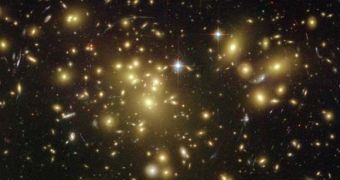Astronomers now believe they may have found the answer to a very old question in the field – how were huge early galaxies able to create massive amounts of stars without devouring each other to gain matter? The answer may lie within the mysterious dark matter, which researchers now say helped channel gas from around the Universe in the earlies galaxies, feeding them the fuel they needed for their cores to become “stellar nurseries.” These are places were hundreds of thousands of stars are created at the same time, in the innermost regions, near the black holes at the center.
Nurseries usually develop when two galaxies collide. The merger of their gases creates a super-heated plasma that is the ideal spawning place for future solar giants. But astronomers have until now believed that, if these conditions are not met, then one galaxy could not have sufficient gas to create stars of its own. And they have thought that the only way gas could have entered one galaxy was through a direct collision with another.
However, that seems highly unlikely to have occurred, as recent pieces of evidence of distant galaxies have showed massive nurseries at their cores, but no traces of past collisions or remnants of the solar systems they devoured. They have thus concluded that gas must reach them somehow, and that dark matter is probably the force behind this transfer.
Researcher Avishai Dekel from the Hebrew University in Jerusalem and colleagues believe that dark matter, which also shapes the cosmic web that supposedly keeps all the galaxies and clusters in check, may have also carried gas along its filaments, to galaxies heavier than the Milky Way. These galaxies would have otherwise rejected gas being attracted by their gravitational pull, via a large number of shock waves generated by their massive size and density.
Nonetheless, upon experiments in the lab, researchers have concluded that gas attached to the filaments was much less likely to be influenced by these shock waves than free gas, and have thus found an explanation of how earliest galaxies, some around when the entire Universe was just 3 billion years old, came to create such large numbers of stars, with no apparent fuel source.

 14 DAY TRIAL //
14 DAY TRIAL //